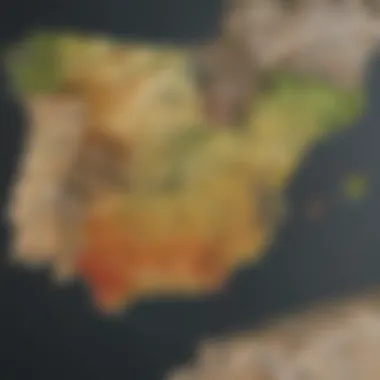Exploring Spanish White Wines: A Comprehensive Guide


Intro
Spanish white wines present a rich tapestry of flavors, aromas, and traditions. Spain, known primarily for its robust reds, offers a surprising variety of white wines that reflect its diverse terroirs and unique grape varieties. This article aims to dissect the nuances of Spanish white wines, allowing readers to appreciate their complexity and historical significance.
In recent years, there has been a growing global interest in these wines. Enthusiasts, educators, and researchers are looking for comprehensive information on the topic. Understanding the characteristics of various regions, grape types, and notable producers is essential for anyone wishing to explore this aspect of Spanish viticulture.
This guide aims to cater to both casual drinkers and serious wine scholars. By addressing specifics, the article seeks to present an organized method to grasp the depth of Spanish white wines. Key components will include detailed explorations of regions such as Rías Baixas and Rioja, insights into grape varieties like Albariño and Viura, and profiles of influential winemakers. Through these discussions, we hope to illuminate the crucial role of white wines in Spain's cultural and gastronomical landscape.
Prelims to Spanish White Wines
Spanish white wines represent a significant part of the country's wine culture and history. They offer a unique perspective on the diverse terroirs and grape varieties that thrive in Spain. Understanding these wines is essential, not only for wine enthusiasts but also for students and professionals interested in viticulture. The exploration of Spanish white wines highlights regional characteristics, reflects cultural practices, and showcases notable producers.
White wines from Spain possess distinct flavor profiles that stem from both the climate and the soil in which the grapes are grown. They vary widely, offering options that cater to different palates and food pairings. With this guide, readers will gain insight into the historical context, cultural significance, and the technical aspects of these wines.
Historical Background
The history of Spanish white wines is intertwined with the cultural evolution of Spain itself. It dates back to ancient times when the Phoenicians and Romans introduced viticulture to the Iberian Peninsula. The Romans, in particular, contributed to the expansion of grape varieties and the establishment of wine regions that remain significant today.
During the Middle Ages, monasteries played a central role in advancing winemaking techniques. Clergy members cultivated vineyards and refined processes, contributing to the development of the wine industry. By the 19th century, Spanish white wines began to gain recognition internationally, especially with exports to France and England. However, the phylloxera plague in the late 1800s devastated vineyards across Europe, including Spain, which led to a revival of national varietals and an increased focus on quality.
Today, regions like Rías Baixas and Rueda are notable for their contributions to the white wine scene, producing vibrant and aromatic wines primarily from indigenous grape varieties.
Cultural Significance
Spanish white wines carry considerable cultural significance, reflecting the traditions and culinary practices of the regions they come from. Wine is deeply embedded in Spanish culture, often enjoyed during meals, celebrations, and social gatherings.
In various regions, specific white wine styles have become associated with local cuisine, promoting food pairing that enhances the overall dining experience. For instance, the crisp Albariño from Rías Baixas is popularly paired with seafood, while Verdejo from Rueda complements lighter fare such as salads and grilled vegetables.
Moreover, the production of these wines often involves family-run bodegas that maintain generational practices. This dedication to tradition not only preserves local heritage but also fosters a sense of community among wine producers.
"Understanding the cultural context of Spanish white wines allows for a deeper appreciation of their flavors and the stories they tell."
Overall, the exploration of Spanish white wines encompasses historical narratives and cultural expressions, enriching the appreciation of these remarkable beverages. Their development encapsulates centuries of tradition, innovation, and a profound connection to the land.
Key Characteristics of Spanish White Wines
Understanding the key characteristics of Spanish white wines is essential for anyone keen to appreciate the complexities of these varietals. Spanish white wines showcase a vast array of flavors and aromas, influenced by the unique climates and soil types in the regions where they are produced. This section delves into vital elements such as flavor profiles and acidity, which are integral to defining their identity and appeal. Knowing these characteristics enriches the experience for consumers and aids in making informed pairing choices with food.
Flavor Profiles and Aromas
Spanish white wines present a rich tapestry of flavor profiles that are appealing to diverse palates. Each grape variety has distinct aromatic qualities that contribute to the overall drinking experience. For instance, Albariño, native to Rías Baixas, is celebrated for its aromas of ripe peach, apricot, and floral notes, often accompanied by a hint of sea breeze due to its coastal origins. On the contrary, Verdejo, primarily from Rueda, is characterized by its herbaceous qualities, often revealing nuances of citrus and fennel.
Additionally, factors like terroir, vineyard management practices, and vinification techniques play critical roles. The use of oak barrels can introduce flavors like vanilla and toast, while stainless steel fermentation can preserve bright fruit characteristics. Understanding these nuances allows consumers to select wines that suit their taste preferences more accurately. Wine enthusiasts may find it helpful to consider the following points when analyzing flavor profiles:
- Grapes and their origins greatly influence flavor.
- Environmental factors like soil composition can alter aromas.
- Winemaking techniques can enhance or mellow certain flavors.
"The exploration of flavor profiles in Spanish white wines is not just about taste; it's an invitation to understand the connection between wine and its environment."
Acidity and Body


Acidity is another pivotal attribute that shapes the character of Spanish white wines. The balance of acidity not only influences the taste but also impacts the wine's freshness and aging potential. Spanish whites, particularly those from cooler regions like Rías Baixas, tend to possess higher acidity, which contributes to their crisp and lively nature. This acidity makes them versatile for food pairing, enhancing dishes without overpowering them.
In contrast, the body of a wine refers to its weight on the palate, affected by factors such as alcohol content and residual sugars. Many Spanish white wines display a medium body, allowing for a balance between richness and refreshment. For example, Airén, extensively grown in La Mancha, is often lighter, making it excellent for warm climate drinking. Meanwhile, fuller-bodied wines like those made from Pedro Ximénez can complement richer foods.
Some key considerations regarding acidity and body include:
- A wine’s acidity often determines how food pairings can elevate flavors.
- Full-bodied wines may require hearty food to maintain balance.
- Understanding acidity helps in identifying aging potential in wines.
In summary, the characteristics of Spanish white wines reveal layers of complexity that merit exploration. The blend of flavor diversity, acidity, and body comes together to create a unique palatial experience. This knowledge not only enhances enjoyment but also fosters greater appreciation for Spain's rich viticultural traditions.
Major Wine Regions of Spain
The importance of understanding the major wine regions of Spain lies in their diverse offerings and how each region uniquely contributes to the character of Spanish white wines. Each area brings distinct grape varieties, terroirs, and winemaking traditions, offering a range of flavor profiles and aromas that appeal to various palates. Recognizing these regions helps wine enthusiasts appreciate the complexity and depth found in Spanish wines. It also serves as a guide for selecting wines based on specific preferences or meal pairings.
Rías Baixas
Overview of the Region
Rías Baixas, situated in northwestern Spain, is renowned for its coastal influence. The climate here is ideal for growing grapes due to the moderating factors of the Atlantic Ocean, which offers cool breezes and ample rainfall. This region is particularly recognized for producing Albariño, a grape that thrives in sandy soils and benefits from the mild climate. The proximity to the sea has a positive effect on the aromatic qualities of the wines, making them fresh and vibrant, which is a beneficial feature for consumers seeking crisp and easy drinking options.
Notable Grape Varieties
The hallmark grape variety of Rías Baixas is Albariño, celebrated for its intense aromas of stone fruits and citrus. Also, a small percentage of other varieties like Loureiro and Treixadura contribute to blends. Albariño's unique characteristic is its balance of acidity and fruitiness. This makes it a popular choice both for casual enjoyment and formal occasions. The wines from this region tend to have a refreshing quality, ideal for pairing with seafood, further enhancing its appeal.
Producers to Watch
Rías Baixas has several notable producers making waves in the wine world. Among them, Pazo de Señorans stands out for its meticulous approach to winemaking, producing some of the finest Albariños. Another key player is Bodegas Martín Códax, well known for both quality and exploration of innovative practices. These producers are crucial in maintaining and elevating the standard of Rías Baixas wines, making them a must-try for any wine lover.
Penedès
Overview of the Region
Penedès, located in northeastern Spain, is often associated with Cava production. However, it also offers a range of still white wines. The diverse terroirs and varying altitudes in this region contribute to a variety of flavor profiles. The Mediterranean climate, along with the proximity to the mountains, creates a unique growing environment ideal for different grape varieties. This region's reputation for quality and diversity makes it a compelling addition to the discourse around Spanish white wines.
Notable Grape Varieties
The Penedès region is famous for several grape varieties, including Xarel-lo, Macabeo, and Parellada, primarily used in Cava production. Additionally, Chardonnay and Sauvignon Blanc have gained popularity for producing high-quality still wines. Each grape variety contributes distinct features, with Xarel-lo often giving body and structure, while Chardonnay brings richness. These characteristics make Penedès wines versatile, appealing to both traditional and modern wine drinkers.
Producers to Watch
Producers from Penedès such as Freixenet and Codorníu are notable for their innovative Cava, but their still wines shouldn't be overlooked. Freixenet, in particular, has embraced sustainability while maintaining high-quality standards. This dual focus on traditional and experimental techniques results in wines that resonate with a variety of consumers, offering both activity and exploration in the glass.
La Mancha
Overview of the Region
La Mancha, one of Spain's largest wine regions, is known for its vast vineyards and historical significance. The central plateau provides a unique climate characterized by hot summers and cold winters. This climate, along with a diverse range of soils, supports an impressive variety of grape growing, making La Mancha a leader in volume production in Spain. For those interested in both quantity and quality, La Mancha serves as a key region to understand in the landscape of Spanish white wines.
Notable Grape Varieties
In La Mancha, Airén is the most planted white grape variety. Known for its resilience in hot climates, Airén produces wines with moderate acidity and fruity notes, making it suitable for blending. It is also gaining attention for its ability to create refreshing, approachable wines. In recent years, the introduction of international varieties like Sauvignon Blanc has added complexity, providing options for consumers looking for familiar flavors in the Spanish wine market.


Producers to Watch
Among the producers in La Mancha, Bodegas Félix Solís is noteworthy for its commitment to both innovation and traditional winemaking practices. Their range of wines showcases the variety potential of the region, bringing La Mancha into the global conversation. With a focus on quality and sustainability, this producer is notable for those looking to explore value-driven wines.
Rueda
Overview of the Region
Rueda is a prominent wine region in Spain, particularly known for its white wines. The climate is continental, which contributes to vibrant acidity—a key feature for many of its wines. Rueda's geographic characteristics, including its high altitude, provide an ideal environment for grape cultivation, particularly Verdejo. The region's focus on quality over quantity elevates its standing among the major wine regions in Spain and draws the interest of wine lovers worldwide.
Notable Grape Varieties
Verdejo is the star grape of the Rueda region. Notably aromatic, it offers hints of green herbs, citrus, and tropical fruits. The grape’s natural acidity and ability to thrive in cooler temperatures make it a solid choice for white wine enthusiasts. Alongside Verdejo, Sauvignon Blanc is increasingly popular, providing consumers with familiarity and distinct flavors, yielding a unique layer to Rueda's offerings.
Producers to Watch
In Rueda, producers like Bodegas Naia are leading the way with their commitment to quality. Known for crafting expressive Verdejo wines, Naia is reshaping the perception of Rueda wines in the market. Bodegas Muga, also noteworthy, emphasizes traditional practices while embracing modern techniques, resulting in wines with depth and character. These producers exemplify Rueda's potential to stand out within Spain's vast wine landscape.
Common Grape Varieties Used in Spanish White Wines
Understanding the common grape varieties in Spanish white wines is essential because these grapes are pivotal in defining the unique characteristics of these wines. Each variety brings its own distinct flavors, aromas, and textures. The benefits of knowing these grape types extend beyond mere classification; they allow consumers to make informed choices when selecting a wine and enhance their tasting experiences. Recognizing the grape varieties leads to a greater appreciation of the wine's complexity and region. Through this section, readers will delve into four prominent grape varieties that define Spanish white wines: Albariño, Verdejo, Airén, and Pedro Ximénez.
Albariño
Albariño is a celebrated grape variety primarily grown in the Rías Baixas region. It is specifically known for its high acidity and bright fruit flavors, making it refreshing and vibrant.
The grape itself thrives in coastal areas, where the Atlantic Ocean imparts a saline minerality to the wine. Notably, Albariño often exhibits notes of peach, apricot, and citrus, with hints of honey and floral undertones. This balance creates a delightful palate experience.
"Albariño's ability to age gracefully adds depth to its appeal, as older vintages show increased complexity."
Verdejo
Verdejo, indigenous to the Rueda region, has gained recognition for its rich, aromatic profile. Its typical flavor notes include citrus and herbs, often complemented by a slight bitterness. Verdejo wines frequently have a medium body and a crisp finish, thanks to their balanced acidity. This grape is versatile and pairs well with various dishes.
Producers are known for crafting both youthful and aged versions, with the latter showcasing deeper flavors and richer textures. The versatility of Verdejo allows for a wide spectrum of wine styles.
Airén
Airén is one of the most widely planted white grape varieties in Spain. However, it's often underappreciated compared to its counterparts. This grape is particularly resilient and adapts well to the hotter climates of La Mancha. While Airén wines are not complex, they tend to be light and refreshing, offering pleasant fruity and floral aromas.
Its importance lies in its significant role in Spain's wine production - it contributes greatly to the country's overall volume of white wines, predominantly in blends. Airén can also be found in some interesting single varietals that reflect its true character.
Pedro Ximénez
Pedro Ximénez, although more synonymous with sweet dessert wines, has a place within the realm of white wines. When cultivated for dry white wine production, it showcases a fresh flavor profile and noticeable sweetness balanced by acidity.
Wines made from this grape are often rich, displaying flavors of figs, dates, and caramel, which can enhance the sensory experience. While its use in dry wines is less common, the depth of flavor possible with Pedro Ximénez allows it to stand out in a world often dominated by lighter varietals.
By exploring these grape varieties, one can better appreciate the nuances of Spanish white wines. Each type contributes to the rich tapestry of flavors that reflect the unique regions they hail from.


Notable Producers and Brands
In the realm of Spanish white wines, understanding the notable producers and brands is crucial. These entities not only contribute to the diversity of flavors and styles but also embody the rich traditions and innovations present in Spain's viticulture. The importance of these producers extends to their influence on wine quality, sustainability practices, and the preservation of regional characteristics. Knowing the brands allows enthusiasts to navigate the extensive selection available, ensuring a more informed choice in both casual sips and serious selections.
Vega Sicilia
Vega Sicilia is one of the most celebrated producers in Spain, widely recognized for its exceptional quality. Established in 1864, the winery is nestled in the Ribera del Duero region. Although mainly noted for its red wines, the options in white, particularly the "Alión" and "Vega Sicilia Cristal," deserve attention. The meticulous care in the vineyard ensures that only the best grapes are used, yielding crisp and aromatic whites with a clear sense of terroir. Their commitment to combining traditional techniques with contemporary methods positions them at the forefront of Spanish winemaking. Moreover, Vega Sicilia’s significant role in promoting Spanish wines on an international scale cannot be overstated.
Marqués de Riscal
Another prominent name is Marqués de Riscal, which boasts a legacy dating back to 1858. This producer is based in the Rioja region and is famed not only for its red wines but also for white varieties like the "Marqués de Riscal Rueda Verdejo." The careful selection of Verdejo grapes showcases the freshness and vibrancy that characterize wines from Rueda. Marqués de Riscal emphasizes sustainability, incorporating practices that respect both the environment and the heritage of the land. Their innovative techniques and modern facilities keep them a step ahead of changing market trends, making them a key player in the Spanish wine industry.
Bodegas Esmeralda
Bodegas Esmeralda represents a blend of tradition and modernity. Founded in the late 20th century, it emerged quickly within the Spanish wine scene particularly in the Catalonia region. Focusing on local varieties, including Xarel-lo and Macabeo, Bodegas Esmeralda produces white wines that are crisp, aromatic, and full of character. Their dedication to quality is evident in every bottle, with an emphasis on minimal intervention during the winemaking process. This approach highlights the inherent qualities of the grapes, allowing the distinct flavors of the region to shine.
"Notable producers and brands are the foundation on which the reputation of Spanish white wines is built. Their commitment to quality and innovation shapes the future of this vibrant beverage industry."
Spanish White Wine and Food Pairing
The pairing of Spanish white wines with food is a topic that warrants careful consideration. Spanish white wines, known for their diverse flavor profiles, offer a unique complement to a variety of dishes. This section aims to highlight the relationship between specific types of wines and culinary options, thereby enhancing the dining experience. Choosing the right wine can elevate a meal, bringing out the best in both the food and the wine.
Understanding food pairing is essential for anyone interested in Spanish cuisine or wine culture. Spanish white wines can vary significantly between regions and grape varieties. This diversity provides a wealth of options that can suit many different ingredients and preparations. It also allows for customization based on personal preferences. When done correctly, the results can be both satisfying and memorable.
Balanced pairings not only enhance flavors but also promote harmony on the plate. Key elements to consider include acidity, body, and flavor intensity of both the wine and the food. As such, thoughtful pairings can transform a dinner into an exquisite culinary journey.
Seafood Dishes
Seafood is a natural partner for many Spanish white wines. The high acidity and crispness of these wines match beautifully with the delicate flavors of fish and shellfish. For instance, a typical Albarino from Rías Baixas bursts with citrus notes, making it ideal for dishes like grilled sardines or shrimp ceviche.
Several types of seafood warrant specific wine pairings:
- Fatty Fish: Richer varieties, such as salmon or mackerel, pair well with fuller-bodied whites like Verdejo. The creaminess in the wine balances the richness of the fish.
- Shellfish: For oysters or clams, a mineral-driven wine like Albariño enhances the briny, fresh flavors of the shellfish.
- Lightly Fried Seafood: A crisp white, like a young Airén, can cut through the grease and cleanse the palate after each bite.
Pairing seafood with Spanish white wines not only highlights the freshness of the ingredients but also showcases the regional characteristics of the wines.
Salads and Light Entrées
Salads and light entrees offer an opportunity for refreshing wine pairings. The crispness and acidity found in many Spanish white wines complement the freshness of greens and vegetables. A salad dressed with citrus vinaigrette and garnished with seafood can be elevated with a glass of Rueda, which contributes aromatic notes to the mix.
Specific pairings can be advantageous here:
- Mixed Greens with Fruit: A Verdejo can enhance these flavors, with its fruit-forward profile complementing figs or citrus being added to salads.
- Grilled Vegetable Platters: The smoky character of grilled vegetables pairs well with lightly oaked whites, such as those found in Penedès. The wine's subtle flavors provide an excellent backdrop to the charred notes.
- Light Pasta Dishes: A simple pasta served with olive oil and fresh herbs can find a perfect partner in a Sauvignon Blanc style wine from Rías Baixas. Its high acidity refreshes the palate.
Finale
The examination of Spanish white wines reveals a rich tapestry of flavors, aromas, and traditions. Understanding the nuances of this segment of viniculture not only enhances appreciation among enthusiasts but also serves as a critical educational foundation for students and professionals alike.
Future Trends in Spanish White Wine Production
As we look ahead, several trends are poised to shape the landscape of Spanish white wine production. Environmental concerns are becoming a greater priority. Sustainable viticulture practices are gaining momentum. Many producers are opting for organic or biodynamic methods, aligning with shifting consumer preferences toward environmentally friendly products.
Additionally, there is a push towards innovation in grape cultivation. Climate change is forcing winemakers to adapt. New grape varieties are being tested in regions traditionally associated with specific wines. This experimentation could lead to unique blends and increased diversity in the offerings.
Moreover, there is a noticeable trend toward globalization. Spanish wines are garnering more international recognition. As the global market expands, Spanish producers are tapping into international audiences, seeking to establish their brands in new markets while enhancing their distribution channels.
In summary, the future of Spanish white wine production appears promising. With an emphasis on sustainability, innovation, and global outreach, the sector is likely to evolve in exciting ways.







